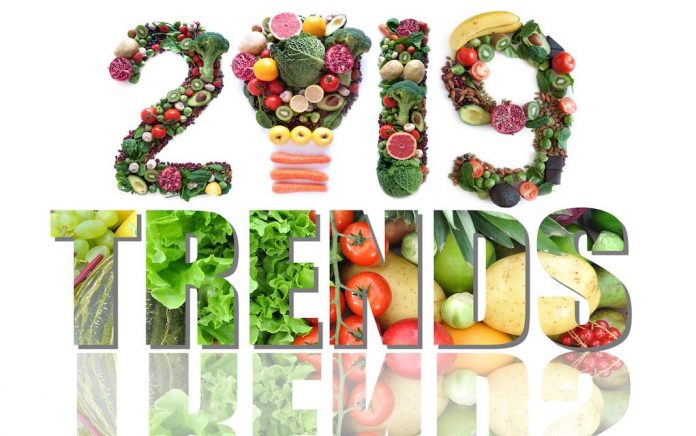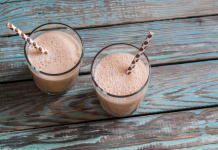
It’s the time of year when food producers, foodies and other food aficionados cast their predictions for the coming year’s food trends. Companies in the food industry want to be right because their profits may depend on it and they want to please their customers. Foodies and aficionados look forward to a year of culinary delights and edible excitement. Others may just want to try something new occasionally when shopping or dining out.
Regardless of the reasons, many people look forward to the newest cuisine hitting the stores, restaurants, and cooking shows in the new year, and 2019 is no different. When we went searching for all of the 2019 predictions and stirred up the brew, here’s what rose to the top of the pot.
Read about food then and now: how nutrition has changed
Collagen. If you are used to seeing the word “collagen” on the ingredient list of your cosmetics, get prepared to see it on food labels. Food and Business News noted many new launches containing collagen can be expected in 2019.
Earth-friendly packaging. It’s no secret that we are drowning in plastic and other types of excessive packaging, and the food industry is beginning to step up and do their part to help alleviate the problem. In 2019—and hopefully going forward—we can expect to see less plastic, more compostable packaging, consumers being urged to bring their own vegetable bags (BYOVB), and multi-use food packaging. Now is the time to dig those canvas and multi-use bags out of your closet, put them in your car and purse or backpack, and use them while supporting eco-friendly brands.
Foreign grains. Despite the low-carb and keto crazes, highly nutritious grains are still in demand. Food and Business News writes how a perennial wheatgrass called kernza and an African nutty grain called fonio will be seen in 2019, perhaps in cereals, promoted as a side dish, and in other forms.
Going buggy. In case you didn’t know, 80 percent of the world’s population already eats insects. So it’s about time, according to some experts, that more of us go buggy. Insects are very high in protein and extremely versatile when it comes to adding bug flour (especially cricket) to a wide range of products, from breads and pastries to pasta and cereals. It’s predicted “these products will soon flood the shelves of grocery stores and restaurants alike.”
Read more about the crickets are coming
Hemp super sized. The rapidly growing interest in cannabinoid (CBD) oil is energizing the hemp food market. According to Food Navigator USA, the fastest growing products have been frozen desserts, functional beverages, meat alternatives, and ready-to-drink coffee and teas. In 2019, look for more foods containing hemp oil, hemp seeds, and hemp hearts.
Innovative ice cream. We all scream for ice cream, and now you’ll be shouting “avocado” and “Turkish ice cream” please in 2019. Producers are set to thrill you with hummus, tahini, nieves de garrafa (a Mexican sorbet), and ice cream with cheese. Get out your cones and spoons and dig into a whole new world of ice cream.
More no-meat options. Plant-based meats are popping up all over, with veggies and especially mushrooms taking center stage as the main no-meat ingredient. We can expect to see a surge in non-meat meaty snacks, such as “pork” rinds, “beef” jerky, and “bacon” treats. Also expect to see a “mushrooming” of the use of more mushrooms, including exotic names such as enoki, maitake, and eryngii.
Pacific Rim. According to Whole Foods, cuisine native to areas of Asia, Oceania, and the western coasts of South and North America will be hot. Get your palate ready for dragon fruit, dried shrimp, cuttlefish, guava, longganisa (a pork sausage from the Philippines), and shrimp paste. Even though you may have already dabbled with other Pacific Rim foods such as monkfruit and jackfruit, this is the year to broaden your horizons.
Sexy healthy fats. If you thought the healthy fats craze had ended, think again. Efforts to keep healthy fats in the public’s eye continue with the introduction of more easy, convenient foods—especially snacks–that contain medium chain triglycerides, coconut oil, ghee, and nut butters.
Shelf-stable probiotics. Beneficial bacteria are nothing new, but they are popular and continue to be in demand. Food producers are going to meet that demand with more functional probiotic ingredients available in a growing array of shelf-stable foods, such as ready-to-eat cereals, nut butters, soups, and energy bars. One reason more of these products can hit the shelves is the availability of new strains of probiotics, such as Bacillus coagulans MTCC5856 and B. coagulans GBI-30. The names may not roll off your tongue, but let’s hope they do their job in our microbiome!
Tsunami of sea vegetables. The number of sea vegetable snacks and other ocean food options will rise with the tides this year. You can expect to see seaweed butter, kelp jerky, plant-based tuna alternatives, and puffed snacks with water lily seeds as an ingredient.
Sources
Breyer M. Top 10 healthy food trends for 2019. Treehugger. 2018 Nov 21
Edelstein LG. Top food trends for 2019. Meetings and Conventions 2018 Sep 12
Food Business News. Ten cutting edge culinary trends in 2019.
Watson E. Where next for the US hemp food and beverage market? Food Navigator USA. 2018 Apr 2










